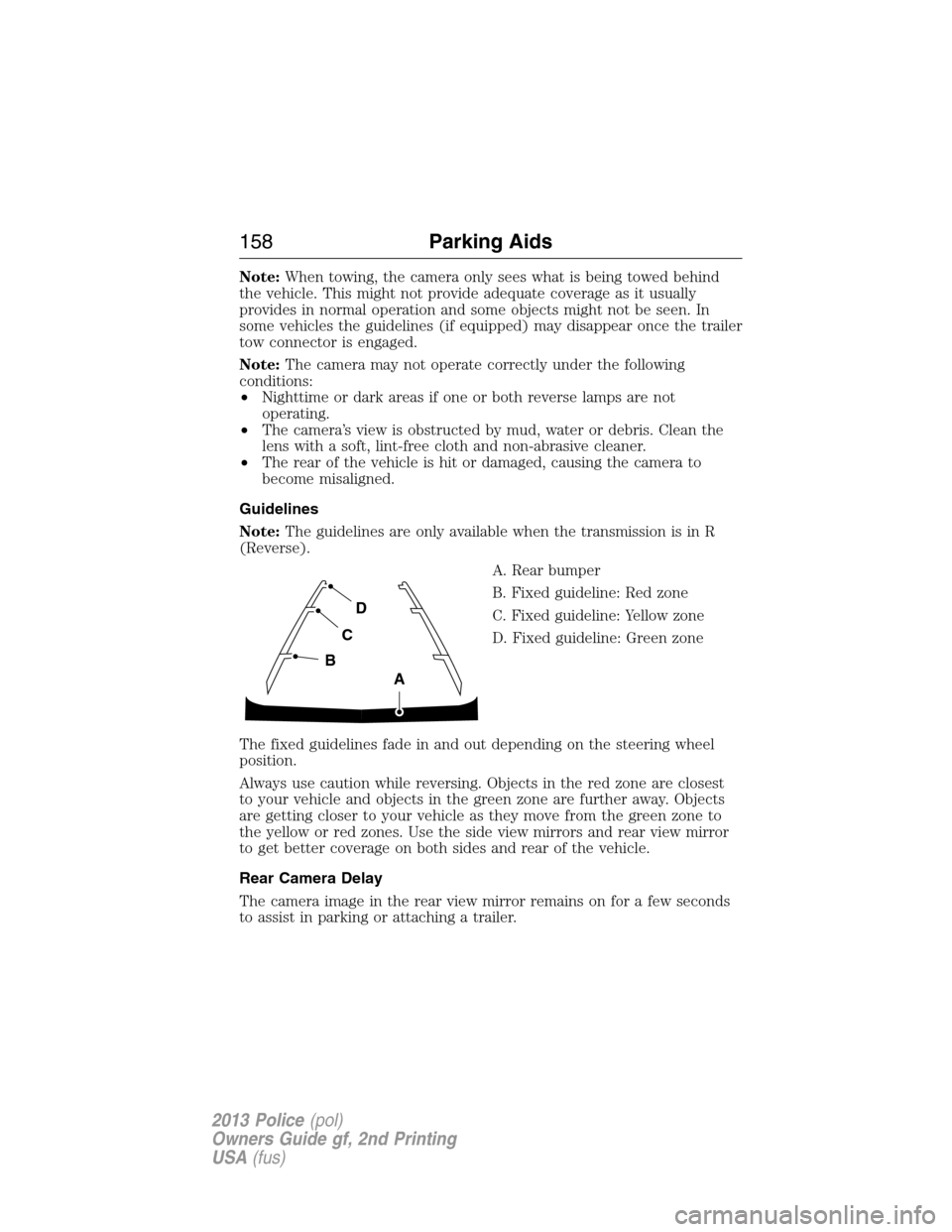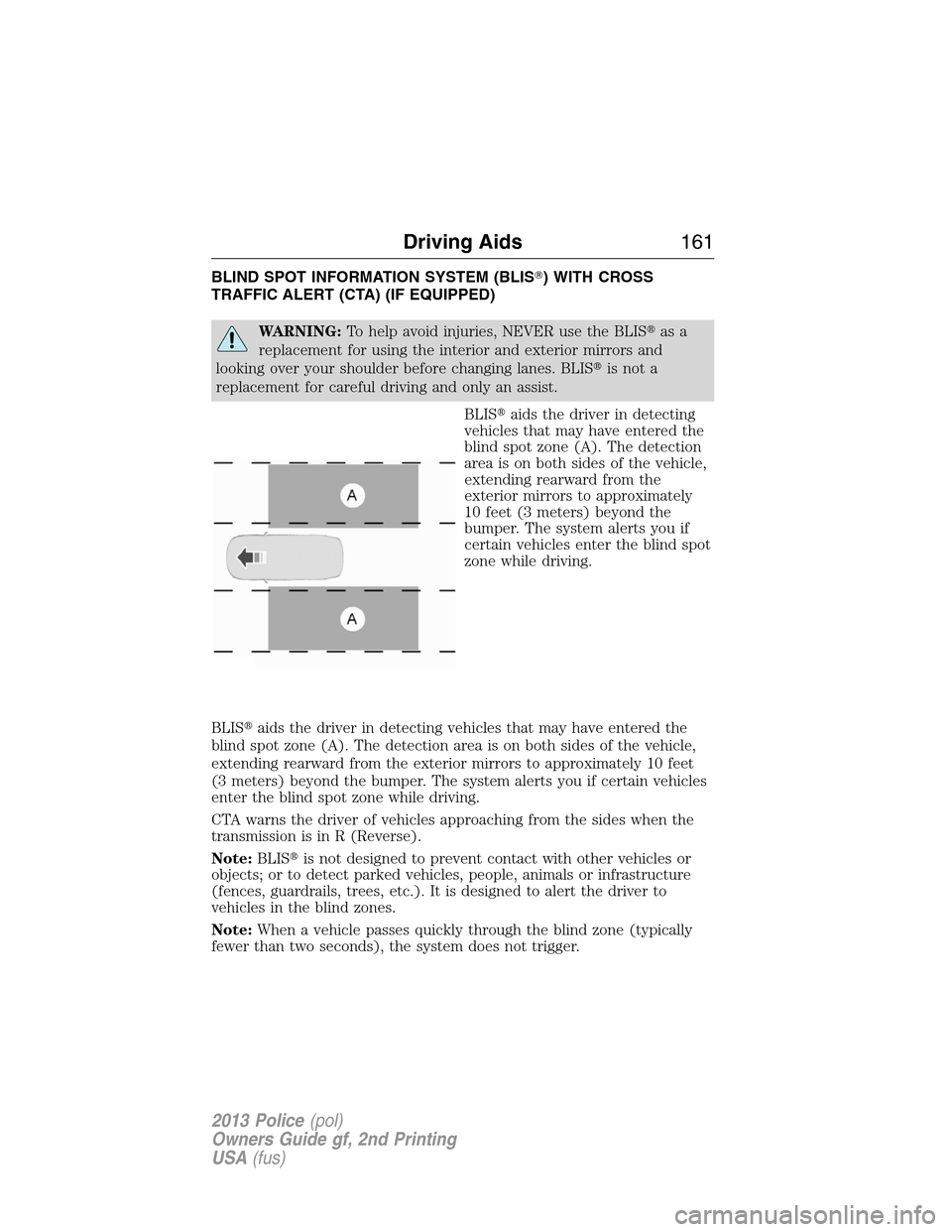Page 158 of 375

Note:When towing, the camera only sees what is being towed behind
the vehicle. This might not provide adequate coverage as it usually
provides in normal operation and some objects might not be seen. In
some vehicles the guidelines (if equipped) may disappear once the trailer
tow connector is engaged.
Note:The camera may not operate correctly under the following
conditions:
•Nighttime or dark areas if one or both reverse lamps are not
operating.
•The camera’s view is obstructed by mud, water or debris. Clean the
lens with a soft, lint-free cloth and non-abrasive cleaner.
•The rear of the vehicle is hit or damaged, causing the camera to
become misaligned.
Guidelines
Note:The guidelines are only available when the transmission is in R
(Reverse).
A. Rear bumper
B. Fixed guideline: Red zone
C. Fixed guideline: Yellow zone
D. Fixed guideline: Green zone
The fixed guidelines fade in and out depending on the steering wheel
position.
Always use caution while reversing. Objects in the red zone are closest
to your vehicle and objects in the green zone are further away. Objects
are getting closer to your vehicle as they move from the green zone to
the yellow or red zones. Use the side view mirrors and rear view mirror
to get better coverage on both sides and rear of the vehicle.
Rear Camera Delay
The camera image in the rear view mirror remains on for a few seconds
to assist in parking or attaching a trailer.
D
C
B
A
158Parking Aids
2013 Police(pol)
Owners Guide gf, 2nd Printing
USA(fus)
Page 161 of 375

BLIND SPOT INFORMATION SYSTEM (BLIS�) WITH CROSS
TRAFFIC ALERT (CTA) (IF EQUIPPED)
WARNING:To help avoid injuries, NEVER use the BLIS�as a
replacement for using the interior and exterior mirrors and
looking over your shoulder before changing lanes. BLIS�is not a
replacement for careful driving and only an assist.
BLIS�aids the driver in detecting
vehicles that may have entered the
blind spot zone (A). The detection
area is on both sides of the vehicle,
extending rearward from the
exterior mirrors to approximately
10 feet (3 meters) beyond the
bumper. The system alerts you if
certain vehicles enter the blind spot
zone while driving.
BLIS�aids the driver in detecting vehicles that may have entered the
blind spot zone (A). The detection area is on both sides of the vehicle,
extending rearward from the exterior mirrors to approximately 10 feet
(3 meters) beyond the bumper. The system alerts you if certain vehicles
enter the blind spot zone while driving.
CTA warns the driver of vehicles approaching from the sides when the
transmission is in R (Reverse).
Note:BLIS�is not designed to prevent contact with other vehicles or
objects; or to detect parked vehicles, people, animals or infrastructure
(fences, guardrails, trees, etc.). It is designed to alert the driver to
vehicles in the blind zones.
Note:When a vehicle passes quickly through the blind zone (typically
fewer than two seconds), the system does not trigger.
Driving Aids161
2013 Police(pol)
Owners Guide gf, 2nd Printing
USA(fus)
Page 162 of 375

Using the Systems
BLIS�turns on when the engine is started and the vehicle is driven
forward above 3 mph (5 km/h); it remains on while the transmission is in
D (Drive) and N (Neutral). If shifted out of D (Drive) or N (Neutral),
the system enters CTA mode. Once shifted back into D (Drive), BLIS�
turns back on when the vehicle is driven above 3 mph (5 km/h).
Note:BLIS�does not function in R (Reverse) or P (Park) or provide
any additional warning when a turn signal is on.
CTA detects approaching vehicles from up to 45 feet (14 meters) away
though coverage decreases when the sensors are blocked. Reversing
slowly helps increase the coverage area and effectiveness.
WARNING:To help avoid personal injury, NEVER use the CTA
system as a replacement for using the interior and exterior
mirrors and looking over your shoulder before backing out of a parking
space. CTA is not a replacement for careful driving and only an assist.
In this first example, the left sensor is only partially obstructed; zone
coverage is nearly maximized.
162Driving Aids
2013 Police(pol)
Owners Guide gf, 2nd Printing
USA(fus)
Page 163 of 375
Zone coverage also decreases when parking at shallow angles. Here, the
left sensor is mostly obstructed; zone coverage on that side is severely
limited.
System Lights and Messages
The BLIS�and CTA systems
illuminate a yellow alert indicator in
the outside mirror on the side of
the vehicle the approaching vehicle
is coming from.
Note:The alert indicator dims when the headlamp switch is not in the
off position and nighttime darkness is detected.
CTA also sounds a series of tones and a message appears in the
information display indicating a vehicle is coming from the right or left.
CTA works with the reverse sensing system which sounds its own series
of tones; see theParking Aidschapter.
Driving Aids163
2013 Police(pol)
Owners Guide gf, 2nd Printing
USA(fus)
Page 164 of 375

System Sensors
WARNING:Just prior to the system recognizing a blocked
condition and alerting the driver, the number of missed objects
will increase. To help avoid injuries, NEVER use the BLIS�as a
replacement for using the side and rear view mirrors and looking over
your shoulder before changing lanes. BLIS�is not a replacement for
careful driving and only an assist.
Note:It is possible to get a blockage warning with no blockage present;
this is rare and known as a false blockage warning. A false blocked
condition either self-corrects or clears after a key cycle.
The system uses radar sensors
which are located behind the
bumper fascia on each side of the
vehicle. Do not allow these areas to
become obstructed by mud, snow or
bumper stickers, as this can cause
degraded system performance.
If the system detects a degraded
performance condition,BLIND
SPOT NOT AVAILABLE,or
CROSS TRAFFIC NOT
AVAILABLEappear in the information display and the alert indicator
illuminates in the appropriate mirror(s). The information display warning
can be cleared but the alert indicator remains illuminated.
When the blockage is removed, the system can be reset in two ways: 1)
when at least two objects are detected while driving, or 2) turn the ignition
key from on to off, then back on. If the blockage is still present after the
key cycle, the system senses again that it is blocked after driving in traffic.
Reasons for messages being displayed
The radar surface is
dirty or obstructedClean the fascia area in front of the radar or
remove the obstruction.
The radar surface is
not dirty or obstructedDrive normally in traffic for a few minutes to
allow the radar to detect passing vehicles so it
can clear the blocked state.
Heavy rainfall/snowfall
interferes with the
radar signalsNo action required. The system automatically
resets to an unblocked state once the
rainfall/snowfall rate decreases or stops. Do
not use BLIS�and/or CTA in these conditions.
164Driving Aids
2013 Police(pol)
Owners Guide gf, 2nd Printing
USA(fus)
Page 203 of 375
Fuse/Relay
NumberFuse Amp
RatingProtected Components
7 — Not used
8 — Not used
9 — Not used
10 — Trunk/liftgate release relay
11 — Rear window defroster relay,
Mirror relay (Sedan)
12 — Run/start relay
13 — Starter motor relay
14 — Engine cooling fan #2 high speed
relay
15 — Fuel pump relay
16 40A** Center console 6 way B+ feed 3
17 — Not used
18 40A** Front blower motor relay
19 30A** Starter relay
20 20A** Center console powerpoint #2
21 — Not used
22 — Not used
23 30A** Driver power seat
24 40A** Police run/start relay
25 — Not used
26 40A** Rear window defrost relay
27 20A** Center console powerpoint #1
28 — Not used
29 40A** Engine cooling fan #1 high speed
power, Engine cooling fan #1 and
#2 low speed primary fuse
30 40A** Engine cooling fan #2 high speed
fuse
31 25A** Engine cooling fan #1 and #2 low
speed secondary fuse
Fuses203
2013 Police(pol)
Owners Guide gf, 2nd Printing
USA(fus)
Page 204 of 375
Fuse/Relay
NumberFuse Amp
RatingProtected Components
32 — Auxiliary blower motor relay
(Utility)
33 — Engine cooling fan #1 and #2 low
speed relay #2
34 — Blower motor relay
35 — Engine cooling fan #1 high speed
relay, Engine cooling fan #1 and
#2 low speed relay #1
36 — Not used
37 — Not used
38 — Not used
39 40A** Auxiliary blower motor (Utility)
40 40A** Center console 6 way B+ feed 1
41 — Not used
42 30A** Passenger seat (Sedan)
43 40A** Anti-lock brake system valves
(Utility)
20A** Anti-lock brake system valves
(Sedan)
44 — Rear washer relay (Utility)
45 — Not used
46 — Not used
47 — Not used
48 — Not used
49 — Not used
50 15A* Heated mirrors
51 — Not used
52 — Not used
53 — Not used
54 — Not used
55 — Wiper relay
56 — Not used
204Fuses
2013 Police(pol)
Owners Guide gf, 2nd Printing
USA(fus)
Page 209 of 375

Fuse/Relay
NumberFuse Amp
RatingProtected Components
25 15A Liftgate release (Utility)
26 5A Ignition switch (Sedan),
Frequency transceiver module
(Utility)
27 20A Not used (spare)
28 15A Ignition switch (Utility)
29 20A Radio, Global positioning system
module
30 15A Front park lamps
31 5A Brake signal for police equipment
32 15A Master window/mirror switch,
Lock switch illumination, Police
console inline delayed accessory
feed, Delayed accessory feed
33 10A Occupant classification module
(Utility)
34 10A Reverse park aid module, Blind
spot monitor module, Rear video
camera
35 5A Motorized humidity sensor,
Overdrive cancel switch (Low
gear switch feed), Column shift –
low gear, Headlamp switch
(Utility)
36 10A Not used (spare)
37 10A Restraints control module
(Utility)
38 10A Auto–dimming mirror, Rear
camera display mirror
39 15A High beam headlamp shutters
40 10A Rear park lamps, License plate
lamps (Utility)
Fuses209
2013 Police(pol)
Owners Guide gf, 2nd Printing
USA(fus)